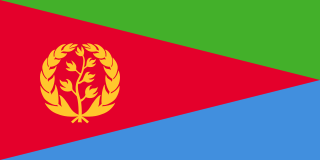Telecommunications in Eritrea are under the authority of the Government of Eritrea.
Public broadcasting involves radio, television, and other electronic media outlets whose primary mission is public service. Public broadcasters receive funding from diverse sources including license fees, individual contributions, public financing, and commercial financing, and claim to avoid both political interference and commercial influence.

Television is one of the major mass media outlets in the United States. In 2011, 96.7% of households owned television sets; about 114,200,000 American households owned at least one television set each in August 2013. Most households have more than one set. The percentage of households owning at least one television set peaked at 98.4%, in the 1996–1997 season. In 1948, 1 percent of U.S. households owned at least one television; in 1955, 75 percent did. In 1992, 60 percent of all U.S. households had cable television subscriptions.

ARD is a joint organisation of Germany's regional public-service broadcasters. It was founded in 1950 in West Germany to represent the common interests of the new, decentralised, post-war broadcasting services – in particular the introduction of a joint television network.

CBMT-DT is a television station in Montreal, Quebec, Canada, broadcasting the English-language service of CBC Television. It is owned and operated by the Canadian Broadcasting Corporation alongside Ici Radio-Canada Télé flagship CBFT-DT. The two stations share studios at Maison Radio-Canada on René Lévesque Boulevard East in Downtown Montreal; CBMT-DT's transmitter is located atop Mount Royal.

Television in Canada officially began with the sign-on of the nation's first television stations in Montreal and Toronto in 1952. As with most media in Canada, the television industry, and the television programming available in that country, are strongly influenced by media in the United States, perhaps to an extent not seen in any other major industrialized nation. As a result, the government institutes quotas for "Canadian content". Nonetheless, new content is often aimed at a broader North American audience, although the similarities may be less pronounced in the predominantly French-language province of Quebec.

Arirang TV (Arirang International Broadcasting) (Korean: 아리랑 국제방송) is an international broadcasting station operated by the Korea International Broadcasting Foundation, based in Seoul, South Korea. It provides English-language information on Korean current events, culture, and history to regions around South Korea.

There are no current independent mass media in Eritrea. All media outlets in Eritrea are from the Ministry of Information, a government source.
Television in Pakistan started in 1964 and the first live transmission of Pakistan Television began on 26 November 1964, in Lahore.

The Ethiopian Broadcasting Corporation, now rebranded as ETV, is an Ethiopian government-owned public service broadcaster. It is headquartered in Addis Ababa, Ethiopia, and is the country's oldest and largest broadcaster.
The television industry in China includes high-tech program production, transmission and coverage. China Central Television is China's largest state-run national television broadcaster. By 1987, two-thirds of people in China had access to television, while today, over 3,000 channels are available in the country.

Azteca Uno, is a Mexican national broadcast television network owned by TV Azteca, with more than 100 transmitters across the country. Azteca Uno broadcasts on virtual channel 1. Azteca Uno programming is available in Mexico on satellite via Sky and Dish Network, as well as all Mexican cable systems, and some Azteca Uno programming were seen in the United States on Azteca América.

Cable news channels are television networks devoted to television news broadcasts, with the name deriving from the proliferation of such networks during the 1980s with the advent of cable television.

Cartoon Network is one of two digital children's television channels that air animated series: Cartoon Network MENA, which serves the Middle East and North Africa division along with Greece and Cyprus; and Cartoon Network Africa, which exclusively serves Sub-Saharan Africa. Both feeds are owned by Warner Bros. Discovery under its International division.
The 2013 Eritrean Army mutiny was mounted on 21 January 2013, when around 100 to 200 soldiers of the Eritrean Army in the capital city, Asmara seized the headquarters of the state broadcaster, EriTV, and allegedly broadcast a message demanding reforms and the release of political prisoners. The mutiny was the first major incident of resistance to the rule of Isaias Afwerki since the purging of a group of fifteen ministers who demanded political reform in 2001. Details about the mutiny remain murky, with several government officials denying it even took place, while opposition sources claimed it had been an abortive coup attempt.
Arirang Radio is an English-language South Korean television network based in Seoul and aimed at an overseas audience. It is operated by the Korea International Broadcasting Foundation and is financially supported by the Ministry of Culture, Sports and Tourism. The channel, which airs in 103 countries, aims to offer an extensive and informative view of Korea Peninsula affairs, as well as world issues from a global perspective.
The General Organization of Radio and TV, also known in French as Organisation de la Radio et la Télévision Arabe Syrienne, is the state and public broadcaster in Syria and reports to the Ministry of Information. Earlier names were Radio and Television and Syrian Radio & Television (SRT).

Fox Sports Racing is a motorsports-oriented cable network owned by the Fox Sports Media Group division of Fox Corporation. The network launched on August 17, 2013 as a replacement of the former cable network Speed for North American markets outside the United States, including Canada and the Caribbean.

TV Verdade is a multinational Brazilian-based religious broadcast station of the international Christian organization, Members Church of God International for the Portuguese-speaking countries.











